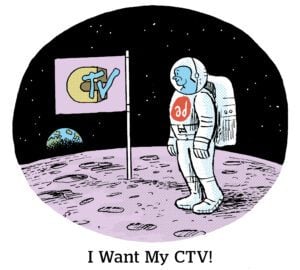SSPs are coming for streaming media.
The average CTV platform now authorizes 30 SSPs to sell its inventory, doubling the number of SSPs streamers worked with last year, according to Jounce Media.
SSPs are packaging CTV inventory into curated, omnichannel deals. But sometimes that CTV inventory is attached to less desirable content or has been resold by other SSPs. Which raises questions as to whether buyers are actually getting what they’re paying for.
And make no mistake, buyers are paying a lot. One of the most noticeable effects of increased SSP saturation has been higher costs due to SSPs reselling inventory, said Jounce Media founder Chris Kane during a presentation at the IAB Tech Lab’s 10th anniversary summit last week.
Auctions that are operated directly by platforms that own the rights to the CTV content they’re selling have a median CPM floor of $14. But the median for auctions operated by resellers is $19.50. This translates to an average price increase of 39% when buying through an SSP reseller, according to the Jounce presentation.
A more convoluted CTV market
Some CTV platforms are adding SSP partners at a frenetic pace. And this has exploded the number of viable supply paths to the same inventory.
Take Paramount-owned Pluto TV, which is among the most aggressive streaming platforms when it comes to SSP partnerships. In the beginning of 2020, Pluto authorized four SSPs to sell its inventory. Today, that number is about 67, according to Jounce’s research.
Now, buying CTV is almost as complicated as buying display impressions, where there’s been far more SSP involvement. But the increased complexity in CTV is mostly limited to cross-publisher programmatic auction packages curated by SSPs, rather than direct deals.
“Several years ago, there would have been only two SSPs you buy CTV from,” Kane said during the presentation. “That might [still] be the case for one-to-one deals, but not for auction packages.”
Curating complexity
Until recently, most CTV ads were purchased directly via single-seller deals, Kane said. Those could be activated as part of a programmatic guaranteed or private marketplace deal.
In most cases, the single seller would be a TV manufacturer that operates a streaming platform, an independent app developer, or the media owner of the streaming content.
For example, say AMC is the media owner. Since its content is streamed on multiple CTV apps, the advertiser might bid for ads across multiple platforms.
Such direct arrangements give buyers more transparency into ad inventory and pricing, Kane said. But they don’t scale effectively, so buyers supplement those deals with other inventory – and that’s typically purchased through an open exchange.
However, “as an industry, we effectively freaked out buyers about the risks of open auction for connected TV,” Kane added. “We told buyers that there are shenanigans that we’re still too immature as an industry to be able to detect as robustly as we do on the web, so watch out in the CTV open market.”
SSPs saw these open-market concerns as an opportunity to step in and “curate the good stuff,” he said.
Benefits carry risks
The benefits of SSPs curating CTV inventory include increased scale, protection from untrusted sellers and pricing flexibility in programmatic auctions, Kane said.
But each of those benefits comes with a parallel risk.
Jounce tracks about 50,000 CTV apps, but maybe a baker’s dozen of those apps would be considered premium by most advertisers and viewers, Kane said. That means the vast majority of inventory shouldn’t be included by SSPs in curated packages that are only supposed to include the good stuff, he said.
And the long-tail media SSPs include in curated packages can, of course, vary in quality.
For example, Disney-owned ESPN could be considered long tail, Kane said, but so could Roku’s Sacred Sounds meditation channel. For advertisers more interested in ESPN than Sacred Sounds, Kane said, they’d be better off buying ESPN directly from Disney rather than through a curated SSP package.
SSPs also often include inventory purchased from other SSPs within their curated packages, which means advertisers can’t be sure they’re buying exclusively from trusted sell-side partners.
Reselling is most common in supply chains operated by OEM device manufacturers, Kane said. Many smart TVs or streaming devices that plug into a TV come equipped with a default free ad-supported television (FAST) channel, such as Samsung TV Plus, LG Channels or the Roku Channel. These channels typically function as large ad networks, he said, and buyers should expect a degree of reselling.
While it’s true SSP auctions give buyers the flexibility to tailor bids to media quality, there’s a caveat: Buyers could end up bidding highly on packages that include only some premium inventory.
And although some intermediaries justify their cut of CPMs by enriching bids with audience data or adding creative flourishes like scannable QR codes, some just take an unnecessary fee, Kane said.
Deal with it
So, what should buyers do to adapt?
“Unfortunately, my recommendation is to deal with it,” Kane said. “There’s a little bit of reselling that’s going to be part of most CTV auction packages.”
However, buyers can use their leverage to make SSPs compete for ad budgets by offering cleaner supply paths, he added.
“Run head-to-head tests,” Kane said. “Have them compete with each other on who can do the best job of curation, who can provide the most transparent reporting and who can secure inventory at the lowest prices.”
















